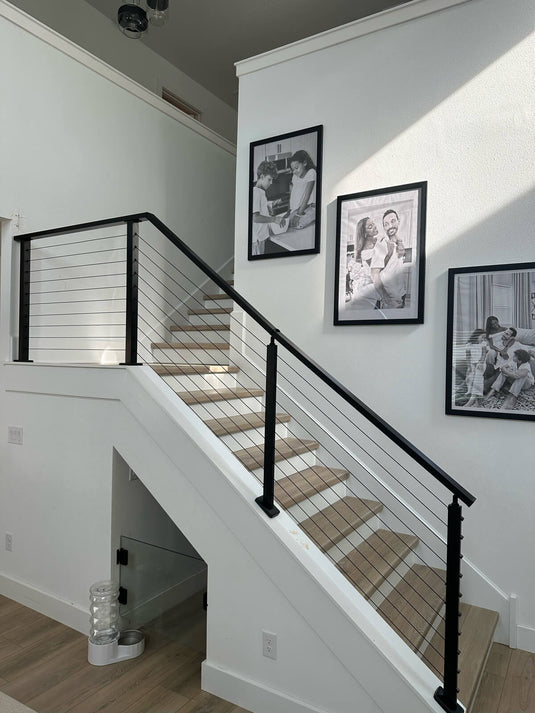TABLE OF CONTENTS
Are Cable Railings Safe for Homes with Pets and Children? Addressing Common Concerns
Cable railing systems offer a fantastic, modern look for decks, stairs, and balconies, and they do a great job of keeping views open. As a homeowner who's done a bit of research and has both pets and kids in mind when thinking about home projects, the question of cable railing safety naturally comes up. Are those sleek, thin cables truly secure enough for our most vulnerable family members? Let's break down the common concerns and what makes a cable railing system safe.

Understand Building Codes and Cable Spacing
To make sure that any railing is safe, including cable railing systems, the most important thing you can do is to follow the building codes in your area. People will prevent falls and get hurt if they follow these rules.
The 4-Inch Sphere Rule
In North America, most building codes say that a railing should not have any opening that a sphere 4 inches in diameter can fit through. This rule is mostly meant to keep little kids from getting through the holes. Before the railing is put up, the horizontal cables must be close enough to each other—usually no more than 3 inches center-to-center when they are properly tensioned—so that they can meet the 4-inch sphere requirement.
Proper Tension is Critical
It's not enough to just leave room between the cables; they also need to be properly pulled together. Anytime the cables are too free, they could make a hole bigger than 4 inches. Manufacturers give guidelines on how much strain to use. When fitting, it's important to stick to these guidelines and check them often.
Addressing the "Ladder Effect" Concern with Cable Railing
The "ladder effect" is a common worry. This is the idea that horizontal cables could look like ladder rungs and make kids want to climb them. This is a valid point to think about.
While the risk exists, several factors mitigate it:
- Cable Tension and Flexibility: Properly tensioned stainless steel cables are quite taut and have minimal give, making them difficult for small feet to gain purchase on compared to, say, wider, flat wooden rungs.
- Slickness of Cables: The smooth, round surface of the cables themselves doesn't offer a lot of grip.
- Adult Supervision: As with any railing system or potential climbing hazard (like furniture), adult supervision for young children is always the most effective safety measure.
Some local codes may have specific restrictions or recommendations regarding horizontal railings due to this concern, so it's always best to check with your local building department before installation.
Cable Railing Safety Considerations for Pets
Different safety issues come up for homes with pets, especially little dogs or cats that want to explore.
Preventing Squeezing Through
Just like with children, the spacing between properly tensioned cables—typically about 3 inches—is usually small enough to prevent most small to medium-sized dogs and cats from slipping through. However, if you're concerned about the tiniest gaps, especially for very small dog breeds (like Chihuahuas or Yorkshire Terriers) or agile, slim cats, there's still a slight chance they might squeeze through.
Chewing or Damaging Cables
Stainless steel cables are very durable, and dogs usually don't want to gnaw on them. But if your pet keeps chewing, you should keep an eye on it, even if injury is improbable. A pet that keeps rushing into or pushing against the cables would be a bigger problem, which shows how important it is to keep the right amount of tension.
Visibility for Pets
The good thing about cable railing is that you can hardly see it. But this could also mean that some dogs, especially those with poor vision or when they're excited, might not see it as a barrier right away. It's important to remember that at first, even though most pets get used to it quickly.
Material Strength and Durability of Cable Railing Systems
One important safety aspect of stainless steel cable is that it is naturally strong. Cable railing systems use wires that have a very high tensile strength, which means they can take a lot of force before they break. It is possible for a 1/8-inch 316 stainless steel wire to break stronger than 1,700 pounds.
Using marine-grade 316 stainless steel, especially for setups outside or near the coast, makes sure that the cable will last and not rust or corrode, which could weaken it over time.
When placed and taken care of properly, the cables are very strong parts of the railing.
Installation Quality: The Lynchpin of Cable Railing Safety
If they aren't put together right, even the best products can be dangerous. This is where careful work with cable railings is really important for safety.
- Secure Post Mounting: The posts are the foundation. They must be securely anchored to the deck structure to withstand the tension of the cables and any impact loads. Wobbly posts mean an unsafe railing, regardless of the cable.
- Correct Fitting Installation: All cable end fittings, terminals, and tensioners must be installed according to manufacturer specifications. Improperly swaged or secured fittings can slip or fail.
- Consistent Tensioning: As mentioned, even tension across all cable runs is vital to maintain the correct spacing and overall rigidity of the system.

Making an Informed Decision About Cable Railing
Cable railing systems are meant to be safe barriers as long as they are put properly and in line with building codes. The important thing is to make sure that the spacing and strain of the cables stop a 4-inch sphere from going through.
Extra care should be taken by families with very young children or pets that like to explore.
You could do the following:
- Make sure that the wire spacing is as close to perfect as your gear will allow
- Check the tightness of the cables on a regular basis.
- Teaching kids that they shouldn't climb on railings.
If safety concerns remain, alternatives like glass panel railings or traditional balusters may be worth considering. Glass panels offer superior visibility and a sleek modern look, while traditional balusters provide classic styling but typically reduce sightlines compared to cable or glass railing. All options have their own benefits and trade-offs in terms of appearance, maintenance, and safety.
Cable railing can be an attractive and safe choice for homes with kids and pets—provided it is properly designed, installed, and maintained to meet both the family’s needs and building requirements. This system offers a clean, contemporary look without compromising safety, as long as proper care and attention to detail are maintained.





